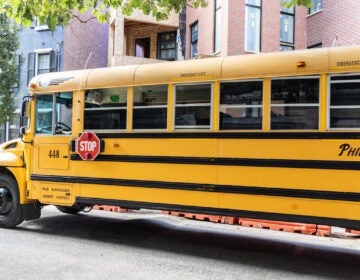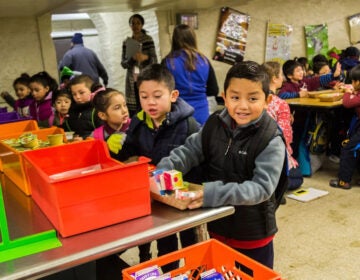Gap between rich, poor Pennsylvania schools doubled in 4 years

Spending gaps between rich and poor school districts in Pennsylvania have more than doubled over the past four years. (NewsWorks file photo)
The gap between what wealthy districts and poor districts spend to educate children has widened dramatically in the four years since GOP Gov. Tom Corbett took office.
The gap between what wealthy districts and poor districts spend to educate children has widened dramatically in the four years since GOP Gov. Tom Corbett took office, amid deep budget-balancing cuts in state aid under Republican-controlled Harrisburg and long-delayed pension obligation payments coming due.
Gaps that existed when Corbett took office have now more than doubled, according to an Associated Press analysis of state data on spending, income and attendance.
The growing disparity that Corbett’s successor, Democrat Tom Wolf, will inherit has helped Pennsylvania earn the label in one study as being among the worst states in educational disparity.
The perception of a damaged educational system under Corbett helped drive his loss in the Nov. 4 election, as Corbett defended his stance on education funding by saying it is more important how money is spent rather than how much is spent.
Pennsylvania already plays one of the smallest roles in school funding of any state, leaving poorer school districts too reliant on an inadequate and often-shrinking local tax bases, the system’s critics say. Bringing the poorest districts into parity with their wealthier counterparts could easily require an additional $1 billion or more.
A look at how Pennsylvania public school spending is changing, overall and by district income levels, over the last four years. The figures are based on an Associated Press analysis of state Department of Education data on Pennsylvania’s 500 school districts.
| Total Spending | 2010-2011 | 2014-2015 |
| By all districts | $25.1 billion | $27 billion |
| By top half of districts in income | $13.82 billion | $15.26 billion |
| By bottom half of districts in income | $11.28 billion | $11.72 billion |
| By top 20 percent of districts in income | $4.14 billion | $4.55 billion |
| By bottom 20 percent of districts in income | $2.03 billion | $2.04 billion |
| Per Child Spending | 2010-2011 | 2014-2015 |
| By all districts | $14,175 | $15,603 |
| By top half of districts in income | $14,514 | $16,434 |
| By bottom half of districts in income | $13,780 | $14,640 |
| By top 20 percent of districts in income | $15,900 | $18,450 |
| By bottom 20 percent of districts in income | $14,174 | $14,425 |
Source: AP analysis of Department of Education data. (2010-11 figures are based on actual total expenditures and average daily membership; 2014-15 figures are based on budgeted expenditures in 2014-15 and average daily membership in 2012-13, the latest statistics available; income is based on 2012 tax data, the latest statistics available).
Shown the AP’s figures, Jim Buckheit of the Pennsylvania Association of School Administrators said that the gap had “exploded.”
This school year, districts in the top half of average resident income are budgeted to spend nearly $1,800 more per student than the poorest half of districts. That’s a 140 percent increase in the size of the gap, or about $1,060 more per student, since the 2010-11 school year, according to the AP’s analysis.
The gap is even wider when considering districts on the farther ends of the income spectrum.
Districts in the top 20 percent of average resident income are budgeted to spend slightly more than $4,000 more per student this year than the poorest 20 percent of districts. That’s a 130 percent increase, or about $2,300 more per student, in the past four years.
Figures for 2014-15 are not final, and could change slightly, as data is updated on attendance and amounts spent. But Buckheit and officials with other education advocacy groups agreed that the trend shown by the data is undeniable.
Pennsylvania’s educational system has returned to the kind of disparity that Corbett’s predecessor, Democrat Ed Rendell, tried to erase by pumping up state aid to public schools by about $2 billion a year.
Corbett, who took office in 2011, pointed to declining enrollments and a yawning state budget deficit and quickly persuaded the Republican-controlled Legislature to cut state aid.
In the meantime, wealthier districts were able to meet rising costs with the help of bigger reserves and deeper local tax bases, but budgets in poorer districts practically froze, just as long-delayed annual pension obligation payments skyrocketed under a 2010 law.
“They can’t make up the difference” from their tax base, Buckheit said. “As these cuts went into place, the only options the (poorer) districts had was to cut.”
In a study published online in July by the Washington, D.C.-based Center for American Progress, Rutgers University education professor Bruce D. Baker concluded that, among all states, Pennsylvania and Illinois harbor the worst inequalities in school finance.
Asked this month about the growing disparity, Corbett didn’t point to his administration’s policies. Rather, he said, it is a subject of great concern that lawmakers must figure out. He also said a system of 500 school districts that make independent budgeting decisions will complicate the effort to decide how much should be spent to educate a child or achieve parity between the rich and poor.
Last June, Corbett signed legislation that set in motion an effort to resurrect an apolitical formula to distribute state school aid, and its suggestions will be delivered to Wolf, who takes office Jan. 20 with a pledge to dramatically increase the state’s contribution to schools.
This year, the state plans to send about $2 billion out of about $5.5 billion in its core school aid program to the wealthiest half of districts. But Corbett suggested that the Legislature’s political role in distributing school aid will frustrate any effort to divert aid to the poor from the wealthy. Closing the gap between the rich and the poor could require an additional $1.5 billion for schools in the bottom half of income.
“So who do I take it away from?” Corbett asked.
WHYY is your source for fact-based, in-depth journalism and information. As a nonprofit organization, we rely on financial support from readers like you. Please give today.




